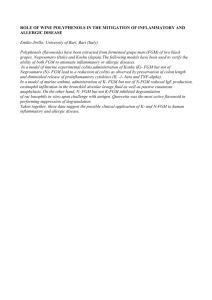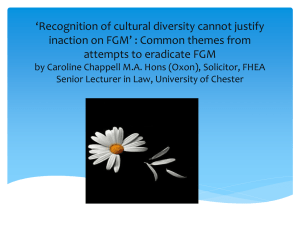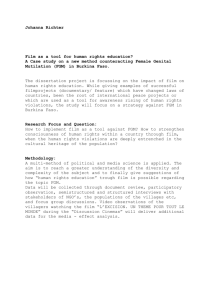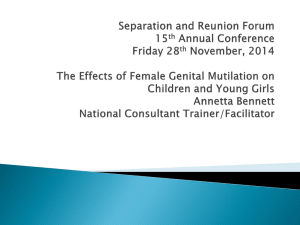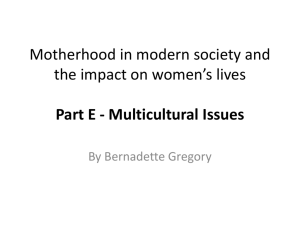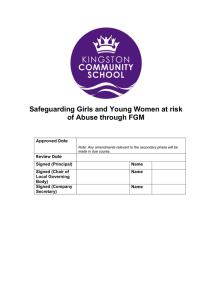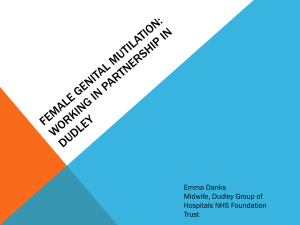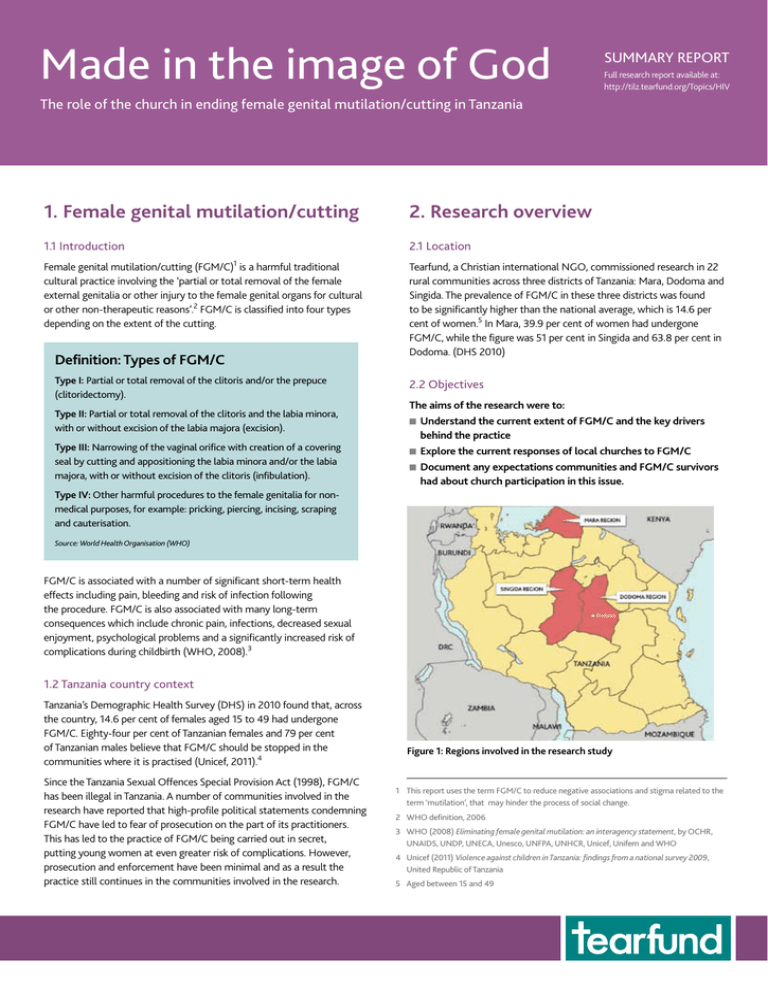
M a d e i n t h e i m ag e o f God
Made in the image of God
SUMMARY REPORT
Full research report available at:
http://tilz.tearfund.org/Topics/HIV
The role of the church in ending female genital mutilation/cutting in Tanzania
1. Female genital mutilation/cutting
2. Research overview
1.1 Introduction
2.1 Location
Female genital mutilation/cutting (FGM/C)1 is a harmful traditional
cultural practice involving the ‘partial or total removal of the female
external genitalia or other injury to the female genital organs for cultural
or other non-therapeutic reasons’.2 FGM/C is classified into four types
depending on the extent of the cutting.
Tearfund, a Christian international NGO, commissioned research in 22
rural communities across three districts of Tanzania: Mara, Dodoma and
Singida. The prevalence of FGM/C in these three districts was found
to be significantly higher than the national average, which is 14.6 per
cent of women.5 In Mara, 39.9 per cent of women had undergone
FGM/C, while the figure was 51 per cent in Singida and 63.8 per cent in
Dodoma. (DHS 2010)
Definition: Types of FGM/C
Type I: Partial or total removal of the clitoris and/or the prepuce
(clitoridectomy).
Type II: Partial or total removal of the clitoris and the labia minora,
with or without excision of the labia majora (excision).
Type III: Narrowing of the vaginal orifice with creation of a covering
seal by cutting and appositioning the labia minora and/or the labia
majora, with or without excision of the clitoris (infibulation).
2.2 Objectives
The aims of the research were to:
nUnderstand the current extent of FGM/C and the key drivers
behind the practice
n Explore the current responses of local churches to FGM/C
n Document any expectations communities and FGM/C survivors
had about church participation in this issue.
Type IV: Other harmful procedures to the female genitalia for nonmedical purposes, for example: pricking, piercing, incising, scraping
and cauterisation.
Source: World Health Organisation (WHO)
FGM/C is associated with a number of significant short-term health
effects including pain, bleeding and risk of infection following
the procedure. FGM/C is also associated with many long-term
consequences which include chronic pain, infections, decreased sexual
enjoyment, psychological problems and a significantly increased risk of
complications during childbirth (WHO, 2008).3
1.2 Tanzania country context
Tanzania’s Demographic Health Survey (DHS) in 2010 found that, across
the country, 14.6 per cent of females aged 15 to 49 had undergone
FGM/C. Eighty-four per cent of Tanzanian females and 79 per cent
of Tanzanian males believe that FGM/C should be stopped in the
communities where it is practised (Unicef, 2011).4
Since the Tanzania Sexual Offences Special Provision Act (1998), FGM/C
has been illegal in Tanzania. A number of communities involved in the
research have reported that high-profile political statements condemning
FGM/C have led to fear of prosecution on the part of its practitioners.
This has led to the practice of FGM/C being carried out in secret,
putting young women at even greater risk of complications. However,
prosecution and enforcement have been minimal and as a result the
practice still continues in the communities involved in the research.
Figure 1: Regions involved in the research study
1 This report uses the term FGM/C to reduce negative associations and stigma related to the
term ‘mutilation’, that may hinder the process of social change.
2 WHO definition, 2006
3 WHO (2008) Eliminating female genital mutilation: an interagency statement, by OCHR,
UNAIDS, UNDP, UNECA, Unesco, UNFPA, UNHCR, Unicef, Unifem and WHO
4 Unicef (2011) Violence against children in Tanzania: findings from a national survey 2009,
United Republic of Tanzania
5 Aged between 15 and 49
M ade in the image of G od
2.3 Partners
Tearfund commissioned 28 Too Many (a charity which aims to eradicate
FGM/C in the 28 countries where it is still practised) to conduct this
research with local Tearfund partners. The partners involved were: Christian
Council of Tanzania (CCT), Africa Inland Church of Tanzania (AICT) Diocese
of Mara Ukerewe, and Anti-FGM Network (AFNET).
The main partner involved in the research was CCT, which is an ecumenical
organisation comprising 14 member churches and ten associate members.
CCT’s vision is one of promoting Christian unity among member churches.
Its programmes include: education, health, interfaith relations, women’s
development, children and gender, peace and justice. CCT has been
working for more than ten years to educate and train communities on
FGM/C and its consequences.
3. Summary of findings
Key points
n
n
n
n
n
n
A legal framework opposed to FGM/C is in existence in Tanzania,
providing opportunity for prosecution and reduction in practice.
Prosecution of FGM/C is minimal, and government intervention has
been limited.
Since the laws6 were passed the practice is being conducted
increasingly on younger girls (sometimes infants) and in secret, for
fear of prosecution.
Community members practising FGM/C are found in both church
congregations and the wider community.
Traditional leaders play a critical role in perpetuating FGM/C – acting
as ‘gatekeepers of the cultural practice’.
Social pressure to undergo FGM/C is high, linked with marriage
opportunities, peer pressure and the economic benefits for
practitioners of the cutting ceremonies.
Participants were asked to estimate the prevalence of FGM/C, the age
range in which the practice occurred and the most prominent type of
FGM/C that occurred within their communities. These estimates were also
compared with the Tanzania Demographic Health Survey (DHS) in 2010.
In Mara region (prominently comprised of Luo and Kurya tribes):
nPrevalence: Community estimates for those communities involved in
the research, were ten per cent (Luo tribe, Rorya district) to 99 per cent
(Kurya tribe, Tarime district) and varied significantly from DHS 2010
levels (39.9 per cent of women).
nAge of practice: Varied estimates between communities, most
estimating 8–10 years or 11–16 years, depending on the community.
nMost prominent type of FGM/C: Type II
In Dodoma region (prominently comprised of Gogo tribes):
n Prevalence: Community estimates for those communities involved in the
research, were 60 to 70 per cent of women underwent FGM/C. These
were broadly in keeping with the findings of the DHS 2010 (63.8 per cent
women). The community estimated that, historically, prevalence was
100 per cent within Gogo communities.
nAge of practice: Estimated between five and seven years/ten and 12
years depending on the community. However, increasingly, FGM/C
has been practised on babies and younger children in this area.
nMost prominent type of FGM/C: Type II was more prominent.
3.1 Key drivers
The drivers of FGM/C varied between communities involved in the research,
but key themes emerged in discussions with community members. These
drivers were seen to be a critical part of any response to FGM/C in Tanzania.
Preparation for marriage and/or childbirth
n‘Uncut’ women have to be cut ‘to become a proper woman’
n FGM/C marks the transition from childhood to adulthood
Prevention of promiscuity/ prostitution
nControlling sexual desire to prevent prostitution/promiscuity
Traditional beliefs and practices
nFGM/C as a blood offering to appease ancestors (mizimu)
n‘Uncut’ women are seen as a ‘curse’ and are segregated and
stigmatised as a result
Social norms and social pressures
nPressure to undergo FGM/C brought to bear by traditional leaders,
parents, wider community and even peers
nSome girls resort to cutting themselves in response to peer pressure, if
their parents oppose the practice
Source of income
nA ‘business issue’ for ngaribas (circumcisers) – traditional elders and
community members who participate in FGM/C ceremonies benefit
financially from FGM/C
nThe cost of cutting (paid to ngaribas, with a share for traditional
elders) ranges from 5,000 Tsh (Tanzanian shillings – approximately £2
or $3) to 10,000 Tsh (approximately £4 or $6)
Link with male circumcision
n Girls seek similar social acceptance and transition into adulthood as boys
Lawalawa
nCommunities in Singida and Dodoma reported that FGM/C is believed
to cure a disease (lawalawa) of the female (and male) genitalia, which
6 Sexual Offences Special Provision Act 1998
Photo: 28 Too Many
In Singida region (prominently comprised of Nyaturu tribes):
nPrevalence: Community estimates for those communities involved in
the research, were 54 to 57 per cent of women underwent FGM/C.
These were broadly in keeping with the findings of the DHS 2010 (51
per cent women).
nAge of practice: Estimated between eight and 13 years depending on the
community. However, increasingly, FGM/C has been practised on babies
and younger children in this area.
nMost prominent type of FGM/C: Both Type I and Type II were practised.
Gogo women near Dodoma, in a community that has seen a decline in FGM/C.
M ade in the image of G od
3.2 Current response of the church
The research sought to document current church activities in response
to FGM/C, as well as to investigate the potential of local churches to
build a more sustainable church-based response to FGM/C. This involved
documenting community and survivor expectations of how the church
could work to end FGM/C.
Mara region
Churches in Mara have adopted a range of positive approaches to
combat FGM/C. Churches are working to sensitise congregation and
community members on the impacts and consequences of FGM/C, and
to engage traditional leaders within these discussions.
CCT has partnered with Norwegian Church Aid for more than ten years
(in Tarime district) to coordinate advocacy campaigns, and to educate
and train community members and traditional leaders on FGM/C and its
consequences. CCT has also worked to disseminate advocacy materials
to churches and schools, with a total of 332 young people participating
in the school advocacy programmes to date. This has resulted in
improved knowledge and understanding of FGM/C and its consequences.
Through local church Sunday School programmes, CCT has sensitised
more than 700 children on FGM/C practices to date. In 2012, a total
of 336 girls sought refuge at pastors’ homes to escape the December
cutting season, which represents an increase in the number of those
seeking refuge compared with previous years.
The Christian Council of Tanzania believes that the local
church can be a driving force for change on the issue of FGM/C
in local communities.
Some churches have provided places of refuge for girls who are fleeing
FGM/C and who are at risk of violence as a result. Other churches have
initiated alternate rites of passage for young girls who want to avoid
FGM/C, but who still want to participate in a ceremony that marks the
beginning of adulthood. Successes were reported with these approaches;
however, some initiatives did face opposition from communities. Some
programmes appeared to be small-scale and not part of a broader
coordinated response.
Photo: 28 Too Many
is thought to be a punishment from the local gods. This has, however,
been found to be vaginal and urinary tract infections that can be cured
with conventional medicine.
Tools of the trade laid down by former ngaribas (circumcisers).
(including HIV). As part of this response, they have included
entrepreneurship training for former ngaribas (circumcisers) to help
them find alternate sources of income.
3.3 Challenges
Many local churches are ideologically opposed to FGM/C and are
actively taking a stand against it, challenging harmful traditional
and cultural practices in their communities. In some communities,
church members had been asked to leave the church because of their
participation in FGM/C, which has led to violence. However, this has
had significant consequences for the church in a number of ways. Lower
attendance, smaller congregations and hostility towards the church were
found to be common. One church pastor explained that he had, in the
past, conducted seminars at primary schools on FGM/C but had stopped
doing so, because he had faced opposition from within the community.
One pastor explained that in some areas the church was the
only body within the community taking any action against
FGM/C. As a result, the church has faced hostility and
resistance to change.
4. Key recommendations for churches
4.1 The potential of the church
Survivors of FGM/C and those who believe the practice must be
eradicated felt it was critical for churches to be an integral part
of the response to FGM/C in Tanzania.
Singida and Dodoma regions
Local churches have been one of a number of community actors working
to eradicate FGM/C, there have been more government and local NGO
interventions in these regions than in Mara, particularly by the AntiFGM/C Network (AFNET).
A baseline study (CCT, 2010) showed that people in Mara region
received education from different sources: 54 per cent by religious
leaders, 30 per cent by media, eight per cent by NGOs/Community
based organisations (CBOs) and six per cent from government officials/
political leaders.
The church has worked to raise awareness, often through addressing
the issue of FGM/C in sermons and preaching. Working in collaboration
with AFNET, churches will host information sessions facilitated by
someone from AFNET to discuss in further detail the impact and
consequences of FGM/C.
The church is an integral part of its community, present in both rural and
urban areas. The local church is well situated to scale up current work
and see an end to FGM/C through the influence and respect it has in
communities.
A number of churches have worked to integrate FGM/C into their work
on HIV. AFNET has produced an integrated training manual which has
been used by churches; this has led to women with HIV and/or fistulae
coming forward for medical treatment.
The Anglican Diocese of Tanganyika has facilitated training with
different social groups on the effects of FGM/C and related issues
Engaging with religious leaders is essential in order to engage
whole communities on the issue of FGM/C and its consequences.
It was said that the government speaks half-heartedly on FGM/C and
does not take an aggressive approach to end the practice. It was also
M ade in the image of G od
said that ‘the church needs to take the lead in showing compassion’. In
another community, a village opinion-leader commented, ‘The church
is the right place to start, in that one could weigh traditions in terms of
what is and is not acceptable to God.’
4.2 Recommendations for action
The following recommendations are made to help build a broader
church-based response, ending FGM/C in Tanzania:
Raise awareness and provide information by facilitating
community-driven discussion sessions on:
nHarmful consequences of FGM/C
nHealth issues related to FGM/C (including dispelling myths such as
lawalawa)
nTanzanian anti-FGM laws (including knowledge and reporting)
Discussions should be organised to include a variety of community
members, including: schools, church congregations, Sunday School,
youth groups, and community meetings.
Create alternative rites of passage
n Facilitate the development of alternative rites of passage for girls
through community participation
nBreak the link between FGM/C and male circumcision by encouraging
male circumcision to take place in hospitals
nProvide incentives and alternative ceremonies for girls refusing FGM/C
Become a ‘safe’ space
nFacilitate ‘safe’ discussion spaces for community members to discuss
openly issues relating to FGM/C in a non-judgemental way
nProvide places of refuge for young women who are facing pressure to
be cut in their community
Support the development of alternative sources of income for
ngaribas (traditional circumcisers)
nFacilitate entrepreneurial activities and support business development
of ngaribas willing to discontinue the practice of FGM/C
Challenge harmful effects of cultural traditions
Ensure key local stakeholders are all engaged fully in discussion groups:
nMen, women, boys and girls from the community
nTraditional leaders
nCommunity and religious leaders (including teachers, doctors, youth
leaders)
Tel: +44 (0)20 8977 9144
Registered Charity No. 265464 (England and Wales)
Registered Charity No. SC037624 (Scotland) 31015–(0114)
Engage and coordinate partnerships both nationally and locally to
achieve:
nA nationally coordinated church response
nInterfaith collaboration between Christians and Muslims
nA community response (engaging schools, churches, mosques and
community leaders)
Enable advocacy and promote effective lobbying
nTo amend the Sexual Offences Special Provisions Act 1998 to ban
FGM/C on women over 18 years and to increase fines for violations
nTo ensure adequate law enforcement and prosecution of cases
nTo ensure that gender equality and the illegality of FGM/C are
adequately enshrined in any new constitution (under the current
constitutional reform process)
nTo strengthen national capacity for improving the quality of health
delivery systems and the level of education for women and girls
(UNFPA, 2007)
n To strengthen the National Plan of Action on the Eradication of FGM/C
5. Next steps
Tearfund and its partners will share these research findings with a wide
range of stakeholders in Tanzania, including church leaders, government
officials and other organisations committed to ending FGM/C.
A context-specific action plan for a church-based response to eliminating
FGM/C will be developed with faith groups, building on their experience
and core competencies. It is hoped that church leaders will demonstrate
their commitment to speak out and mobilise their communities to
address the priority needs identified by survivors and community
members. Survivors will play a key role in shaping this response.
In order to see Tanzania free of the practice of FGM/C, the church must
play a central role in working alongside communities to critically analyse
the impact and consequence of cultural practices, and to discern which
elements to retain and which to abandon. Tearfund seeks to build
models of good practice in focus communities that can be shared in
other communities and countries involved in the practice of FGM/C.
Partners
Christian Council of Tanzania (CCT)
Mary Shuma, Programme Officer for
Women Development, Children and
Gender
wdg@cct-tz.org
AFNET (Anti-Female Genital
Mutilation Network)
Mbiki Mumba, Deputy Director
mbikimumba@yahoo.com
Tearfund would like to acknowledge
the following people who participated
in the research:
100 Church Road, Teddington,
TW11 8QE, United Kingdom
Facilitate broader partnerships and collaboration
CCT Member: Africa Inland Church
of Tanzania (AICT), Diocese of Mara
Ukerewe
Peter Ngwili, Development Programme
Coordinator
ngwilip@yahoo.com
© Tearfund 2013
www.tearfund.org
Promote changed views among young men, and other community
members, on what constitutes an ‘acceptable wife’.
Researchers
Johanna Waritay and Dr Ann-Marie
Wilson from 28 Too Many
annmarie@28toomany.org
For more information on the full
research report, please contact:
Justin Nyamoga, Country Representative
justin.nyamoga@tearfund.org
Written by: Shannon Thomson and
Sarah Reilly
Editor: Veena O'Sullivan

